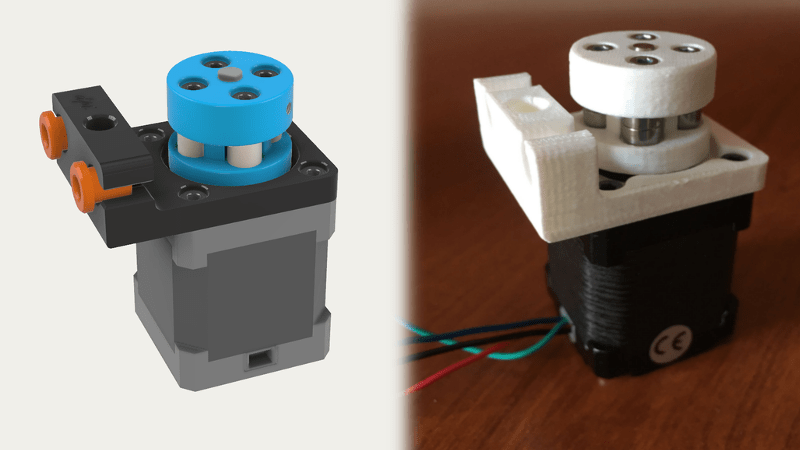With the proliferation of 3D printing in the new millennium, stepper motors are no longer those idle junkbox inhabitants you pulled out of a dot matrix in 1994 and forgot about ever since. NEMA standard parts are readily available and knocking about just about everywhere. Now, you can readily turn a stepper motor into a peristaltic pump with just a few simple 3D printed parts.
The pump consists of a bracket that fits on to a standard NEMA-14 stepper motor frame. A rotor is then fitted to the motor shaft, constructed out of a 3D printed piece fitted with a series of standard roller bearings. These bearings roll against the tubing, pumping the working fluid.
The design uses the bearings to squeeze outwards against the tube’s own elastic resistance. Frictional wear is minimised by ensuring the tube is only pressed on by the bearings themselves, avoiding any contact between the tubing and hard plastic surfaces.
While the design is in its early stages of development, we’d be interested to see a pump performance comparison against other 3D printed peristaltic designs – we’ve seen a few before!
[Thanks to Baldpower for the tip!]
















Looks nice, one thing to be aware of if using this to deliver metered quantities is that the tubing will age as it is worked and you’ll get a variation in delivered rates. If you need exact flow rates then it is either a case of sticking on a flow meter and closing the loop or regularly changing the tube and re-calibrating the pump.
Another thing is that the tube goes flat when the pump stands idle for a few months, so if you’re planning to build a barbot, be sure to drink often.
Also, sticky liquors glue the tube shut when the leftover liquids evaporate.
Sounds like a flush cycle is needed between every dispensation. And not just stickiness but preventing cross-contamination. As for going flat one wonders if a retractable roller design would help?
I think that going flat may be related to the tubing material, rather than the rollers. Perhaps a pressurized “inactive” stage would be a good solution?
Yes. If you leave the pump standing for a long time, the rollers will be pinching the tube for so long it won’t open up again.
I was thinking of making a barbot out of a bunch of peristaltic pumps, but I ran into this exact issue because the pumps would stand still for a long time, so you’d pretty much have to replace all the hoses every time before you took the bot out for a party and dismantle it every time after use. That, plus the sticky liquors problem would mean that you can’t leave the bottles in, so you can’t have this robot bartender waiting in your drinks cabinet either – unless you cycle every bottle every couple days.
It’s kinda like the problem with inkjet printers. Every time you need it, the nozzles have dried up.
If you need exact quantities the best choice is syringe pump or piston pump, and for picoliters scale piezo pumps
I just bought a couple DC motor driven peristaltic pumps from China via ebay. The motors are fast and low torque, and they avoid using a gearbox by putting the rollers between the motor shaft on the inside and the tubing on the outside. The rollers are much larger diameter than the motor shaft so they get reduction/torque multiplication that way (relying on friction between the rollers and the shaft). I ordered with BPT tubing which is supposed to last much longer (some sites claims 30x) than silicone tubing.
They use standard, cheapo brush type motors, so who knows how long they’ll last, but otherwise, they seem to be reasonably well made. I paid $8 for each pump.
https://drive.google.com/file/d/1MTWEvyNOwhyiliIpk42yOZv2pQaoVZuA/view?usp=sharing
I’ve been looking into peristaltic pumps and static mixers for use with plastic resins that have a 1:1 volume ratio.